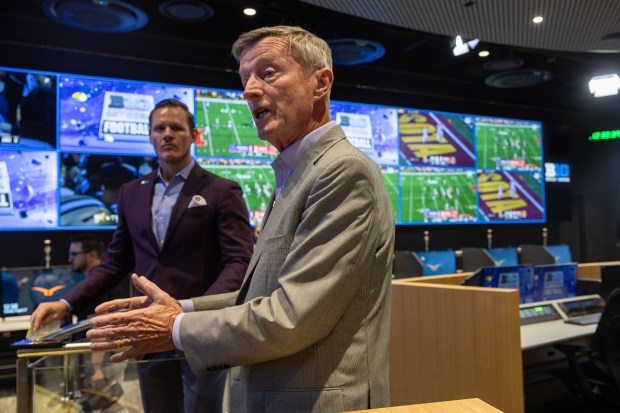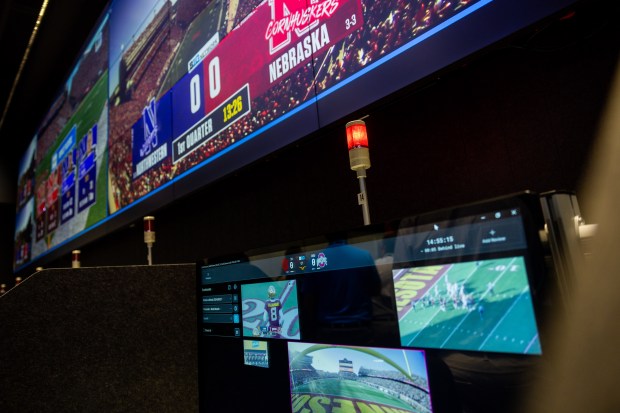When you look around at the banks of video monitors and hear officials talk of “CROs” using a “Hawk-Eye” system, you might think you had stepped into a military mission control room.
But the only long bombs being watched are of the football variety.
CRO is the Big Ten’s shorthand for “collaborative replay official,” and Hawk-Eye is the software they’ll be using to review plays on the football field this season — all part of high-tech upgrades conference officials showed off Tuesday at the Big Ten’s new state-of-the-art replay center at its Rosemont headquarters.
“This is really the marriage of great people and great technology,” Commissioner Tony Petitti said. “This still comes down to people having to make decisions, sometimes very difficult, very close decisions. And our job in this replay center is to provide the technology, the speed, the looks, the ability to make great decisions as quickly as possible.”
College athletics has been catching up to professional leagues with the replay systems it uses, and the Big Ten wanted to branch out on its own from the Pittsburgh-based DVSport replay center that it shared with other NCAA conferences.
Construction started in January, and the conference spent an undisclosed sum to remodel its former Big Ten Experience museum into a 2,000-square-foot control room with 18 replay stations, touchscreen monitors, Xbox controllers, soundproof walls and other fancy features.
“When you talk about sort of the arms race, technology is always improving,” Petitti said. “I came from MLB. We built a brand-new replay center there during my tenure. And just the technology is changing. … Being able to take advantage of those improvements to do things more quickly, more looks, faster, better — it’s a lot of pressure on the people in this room to get things right.
“These are high-stakes games, and a lot of these replays are at the most critical moment of a game in many cases. And so what I really care about is giving them the technology they need, training them properly, so that they can make these decisions in real time and feel good about that.”
A.J. Edds, vice president of football administration and a former Iowa linebacker, said the new setup has a few advantages over what the conference had in Pittsburgh.
“The video boards, these video walls are larger, more dynamic, more versatile, so we can see more (angles) all in one snapshot,” he said. “The internet connectivity is unmatched. It is virtually latency-free. It is real time.”
When a questionable play comes up for review, a CRO alerts one of four replay center supervisors by turning on a red tally light at his or her station.
An audio setup allows for a four-way conversation among the on-field referee, replay booth official, CRO and supervisor. The supervisor makes the final call from the replay center.
Bill Carollo, coordinator of football officials, picks the replay center staff, most of whom work part-time. Some former referees and other on-field officials have been hired to work at the center, but contrary to conventional wisdom, they don’t always make the best replay reviewers, Carollo said.

“We look for more analytical, process-oriented (people): engineers, lawyers,” he said. “We hire a lot of lawyers, for instance, that are replay people, and sometimes they never worked on the field. Dean Blandino never worked on the field, maybe the best replay resource in the country, in the world, when it comes to that.
“So it’s a different skill set than the people on the field and different type of thinking. So we test them for replay skills. We test them for on-field skills, aptitude, cognitive and so on. And the bar’s set pretty high for replay people.”
Edds gave a hypothetical example of how the system might work, from on-field official up to supervisor at the replay center.
“Let’s say a ball carrier’s reaching for the goal line and his knee might have been down before he reached the goal line,” Edds said. “So on the field, they might have called it short of the line to short of the end zone.
“But the play goes to review and we can take all the angles that are available. It could be from down this line, down this line, a back angle — there might be a skycam angle that helps — and we can stitch all of those together so that they’re synchronized. So as they go frame by frame on the Xbox controller, it shows each one of those cameras as it advances for the frame. So they can find exactly where the ball was when the knee went down.
“And if that ball broke the plane, then we would say, ‘This a touchdown.’ … (But) if they say, ‘Oh, this is confirmed, he was in fact short of the end zone with the ball when his knee went down,’ we would communicate that back down to the field.”
The referee would make the announcement at the stadium and for the TV audience.
“He confirms what he heard as the outcome, and then it’s back to play,” Edds said.



